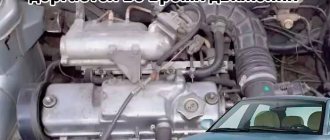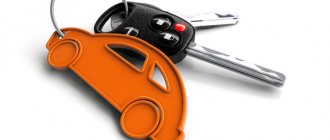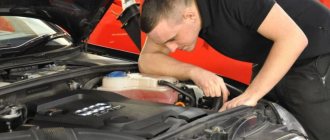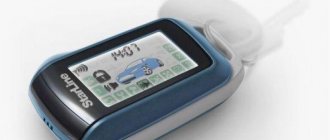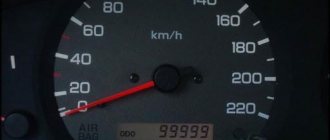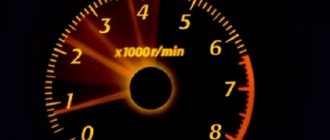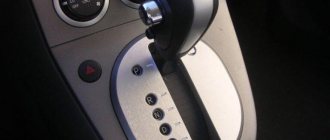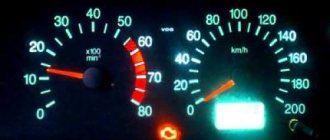Malfunctions and disturbances in engine operation can manifest themselves in different ways, starting with suspicious sounds coming from under the hood, leaks that remain on the asphalt after a long stay, ending with jerks while driving.
Jerking while the car is moving can occur no matter how much you press the gas pedal; this occurs as a result of a short-term change in the speed of rotation of the crankshaft. Dips can occur not only during acceleration, but also when releasing the gas, as well as with constant movement and the same position of the gas pedal. In order to understand why the car jerks when driving, it is best and easiest to contact specialists at a service station, because, most likely, you will have to carry out a complete diagnosis of the fuel system and injection system, and for this, as you understand, you need to have special equipment . In most cases, jerking while driving occurs due to a lack of pressure in the fuel rail, or as a result of a malfunction of the throttle position sensor (TPS).
Failures in the engine power system
The main fault causing the jerk is the wrong fuel mixture. Because of this, the car behaves non-standardly:
- twitches when you press the gas pedal and does not gain speed or does so very reluctantly;
- suddenly and spontaneously changes speed.
A lack of gasoline or diesel fuel in the fuel mixture does not allow the engine to develop standard power. Why does the power system fail? There are several reasons: filter, throttle assembly, fuel rail, air ducts. These units become clogged or worn out, lose their tightness or pressure. In all cases, proper diagnostics are required to find and fix the problem.
Incorrect operation of the ignition system
The ignition system also causes unstable engine behavior due to:
- spark plugs - the fault is easily determined by the color of the deposit and the size of the contact gap;
- high-voltage wires - it is recommended to check with a megger;
- coils - visually inspected for cracks and current leakage.
It is advisable to check spark plugs with a special spark plug. It will allow you to correctly determine the gap between the electrodes, which is normally 1-1.3 mm (on carburetor cars - 0.7-0.8 mm). Increasing this value leads to damage to various ignition system devices. Any known-good spark plugs are also used as a tester.
The coil is also checked for spark. Diagnostics will require a spark plug wrench and pliers. During the test, the ignition must be turned off. Then any armored wire is removed and connected to a known working free spark plug. Next, the engine is started and the spark that appears between the electrodes of the spark plug is examined. Its color should be bright purple.
Poor engine performance is often caused by a short circuit or open circuit in the low voltage circuit. Incorrect connection of the wires to the spark plugs also significantly reduces the performance of the internal combustion engine, causing interruptions.
Transmission breakdowns
Engine malfunction may be caused by damage to the transmission. Most often, the clutch wears out or the grenades break. Less often, the gearbox and its mounting components, including the supports and brackets of the power unit, fail.
The most difficult thing to determine is the failure of the gearbox and clutch - they have to be dismantled and disassembled. It is much easier to diagnose the condition of the airbags and CV joints by using a lift or inspection hole. To check their mobility, the hinges are pumped in different directions. Breaks in motor supports are detected as follows: take a long crowbar and lift the motor (box) near the attachment points. Damage is immediately noticeable.
Jerking when starting the car and when braking
A faulty car can behave differently - move smoothly when accelerating, but jerk when starting off. Here the reasons for jerking are different; most often jerking in such cases occurs due to:
- poor grip;
- faulty gearbox;
- torn engine or gearbox mounts;
- large play in the inner CV joint.
It is difficult to determine the condition of the clutch and gearbox parts visually; usually, in order to find the “culprit” of the breakdown, you have to disassemble it - remove the gearbox and clutch basket. But the condition of the CV joint or engine mount is easier to identify; diagnostics here are not complicated; it is only advisable to drive the car onto a pit or a lift.
The inner CV joint is checked as follows - you need to go down under the car and try to rotate the drive shaft with your hand along and against the movement (rock it). If there is play in the CV joint, the shaft will rotate slightly, but the hinge itself will remain motionless. If the car jerks when starting off due to the wheel drive, the play in the joint should be quite large.
In order to check the engine or gearbox mount, you must:
- take a pry bar and try to raise and lower the engine/gearbox at the place where the support is attached;
- In this case, you need to look carefully at the pillow; if it is torn, the tears can be seen.
When the support is completely torn off, when you sharply press the gas pedal, the engine jerks noticeably under the hood. By the way, when the airbags are torn off, jerks often occur when the car stops, especially when braking sharply.
Bad fuel
Today, fuel is spoiled not only by water, but also by various unknown additives. This fuel contains a lot of sulfur, benzene, aromatic hydrocarbons and ethers. Therefore, all vehicle systems are subject to increased loads. First of all, the injector, ignition, and exhaust suffer. Then, due to increased detonation, the engine overheats - the pistons, rings, and cylinder walls are damaged.
If you have already poured a low-quality composition, get rid of it immediately! Empty the tank, flush the fuel system, clean the injectors and replace the spark plugs. Only after these steps, refuel with good fuel.
Clogged air and fuel filters
On cars of recent years of production, several fuel filters are used. Their main task is to capture large and small deposits and impurities - the power system and internal combustion engine do not tolerate dirty fuel well. There are fine and coarse cleaning elements - the latter are a mesh and are located inside the fuel pump. The filter life is limited - they last 15–30 thousand kilometers. The mesh can last up to 100 thousand km. The main sign of blockage is jerking and jerking of the vehicle. At the same time, other disadvantages arise:
- fuel consumption increases;
- The power of the power unit decreases - acceleration deteriorates;
- The motor stops spontaneously at idle or while moving.
A dirty fuel filter is replaced, or less often cleaned.
Almost the same thing happens with a dirty air filter. The car jerks even more intensely, and engine detonation increases. Then the spark plugs fail, and all the electrics begin to “go crazy”, showing various warnings such as Check Engine on the display. A new filter costs about 200–300 rubles, so it is advisable to replace it frequently - every 10 thousand kilometers.
Simple DIY repair
If it is difficult to find the reason why the car moves jerkily when driving, you should contact a car service center and carry out diagnostics, but before sending the car in for repair, the driver can carry out basic maintenance himself. What you can do with your own hands:
- replace the air and fuel filters;
- clean the engine and attachments from dirt;
- check the condition of high-voltage wires and the ignition module;
- conduct a visual inspection of the engine compartment - there should be no oil leaks, traces of brake fluid or antifreeze;
- Replace the air filter pipe if it is torn.
A dirty engine often causes high-voltage wires to break through to ground. It is convenient to check whether the ignition coil or I/O wires are breaking through in the dark and silence; any sparking becomes clearly visible visually, and you can also hear clicks when a breakdown occurs.
Clogged or faulty injectors
During prolonged operation of an injection engine, varnish and resin deposits from fine particles and heavy fractions of sulfur, hydrocarbons, and ethylene accumulate on the injectors. They greatly slow down the operation of the injection system, change the direction and shape of the spray, and in some cases completely shut off the fuel supply. Obviously, in such a situation, the formation of fuel worsens, the tightness of the regulators is broken, and the overall performance of the internal combustion engine decreases. Therefore, the car moves jerkily and twitches.
Replacing injectors according to manufacturers' recommendations should be done every 120–150 thousand kilometers. But it’s much more important and important to clean them. This must be done at least every 30 thousand mileage, especially in Russian road conditions.
Popular brands:
Kia Sportage
Ways to solve the problem
You can solve the problem of why the car starts to jerk and stops accelerating on your own - or by contacting specialists. Most malfunctions that cause the car to jerk can be quickly and easily corrected with your own hands:
- Diagnose errors using a tester (if possible), then fix them;
- You buy new filters and change them, the replacement will take a few minutes;
- It is better to change all the spark plugs - as a set, so that the engine does not start jerking after 1-2 thousand kilometers, due to the failure of another old spark plug;
- Armored wires cannot be twisted or soldered - this reduces the spark strength and the problem with overclocking is not solved, just replace it as a set;
- Coils cannot be repaired, only replaced;
- The distributor can be replaced entirely, or repaired by replacing only damaged elements;
- The carburetor needs to be adjusted if the fuel supply is disrupted;
- The injector throttle valve should be replaced if flushing does not help;
- Faulty sensors must be replaced;
- Broken wiring can be restored by soldering the break points or tightly twisting and insulating the connection points;
- It is better to change the automatic transmission oil at a service station, because at home, without the necessary equipment, it will not be possible to completely drain the oil and remove dirt and chips. The oil channels will quickly become clogged and the box will begin to jerk again;
- Clutch repair is carried out by replacing failed parts;
- Low-quality fuel should be drained immediately and high-quality fuel should be added;
- A faulty fuel pump is easier to replace; most often it is not repaired; it is repaired if possible;
- It is easier to clean sensors or injectors with special cleaning agents, of which there are many on the car market. They are simply added to the fuel and no cleaning assistance is needed;
It is not always possible to identify or correct a serious breakdown on your own, therefore, if when you press the gas the car jerks while driving, contact a service station when:
- There are problems with the computer and you need to reconfigure, flash or update the software;
- Problems with the automatic transmission;
- If you do not understand the design and repair of the machine at all, or you were unable to independently identify and eliminate the reason why the engine began to twitch;
- It is not possible to repair the car yourself or serious repairs are required;
- It is not possible to conduct computer diagnostics (for injection cars).
Other reasons
Engine malfunctions are also caused by other factors:
- problem of the idle speed sensor - contamination, damage or combustion of the winding;
- dysfunction of the fuel tank - often in summer a vacuum forms inside the tank due to a tightly fitting filler cap, the pump is not able to pump out fuel normally;
- damage to the fuel pump - you can check the operation of the unit without removing it, just evaluate how the mechanism pumps manually;
- wear of the distributor - it should be dry under its cover, be sure to also check the operation of the vacuum and centrifugal regulator;
- incorrect setting of ignition timing;
- incorrect operation of the processor - electronic control.
Remember that failures are also caused by the engine itself - breakage of oil scraper rings, burnout of pistons, scuffing of cylinders. It is possible to accurately determine the “culprit” only after a detailed inspection of the machine components.
It is better to entrust diagnostics to specialized car services, as they do in Moscow, St. Petersburg, Novosibirsk and other cities. For example, on BMW models, a drop in engine power is possible due to the VANOS sensor, and on Mercedes-Benz and some other foreign cars - due to a “glitch” in the program responsible for integrating the engine with the gearbox. This can be checked correctly only with professional instruments.
The car jerks when driving when changing gears - check the gearbox
If you have a car equipped with an automatic transmission (whether it is a standard automatic transmission, a CVT or a robot), most likely, this module is the reason why the car jerks while driving. Any problems that arise when shifting gears are related to the operation of the box, but this cannot always be determined. Especially great difficulties arise when using a CVT variator - a continuously variable transmission.
The most common problems with car jerking when switching occurred with German tiptronics installed on many models in 2002-2007. If you find problems with the car jerking when automatically shifting on a standard automatic, robot or tiptronic, perform the following test procedures:
- increase the acceleration dynamics and try to notice whether the car jerks when switching to the last gear;
- switch the transmission control mode to manual mode and check if the twitching disappears;
- check whether the symptom continues when shifting to lower gears;
- Drive for a few minutes in one gear (not the last one) and note the symptoms.
If the car twitches during any switching options, it means that the gearbox is definitely involved in this problem. In some cars, repairing a high-tech automatic transmission turns out to be too expensive, sometimes an aggregate replacement can be cheaper.
If you have a CVT installed on your car, it is impossible to determine its involvement in unpleasant manifestations. You will have to go for diagnostics and clarify the reasons for this behavior of the car. In this case, it is better to choose an official service station with branded equipment. Otherwise, the diagnostics may not be of sufficient quality, you will be told to replace the working units, and you will have to spend a lot of money on unnecessary repairs.
